Request Forms
Clean, flexible request forms for streamlining customer and internal submissions.
-
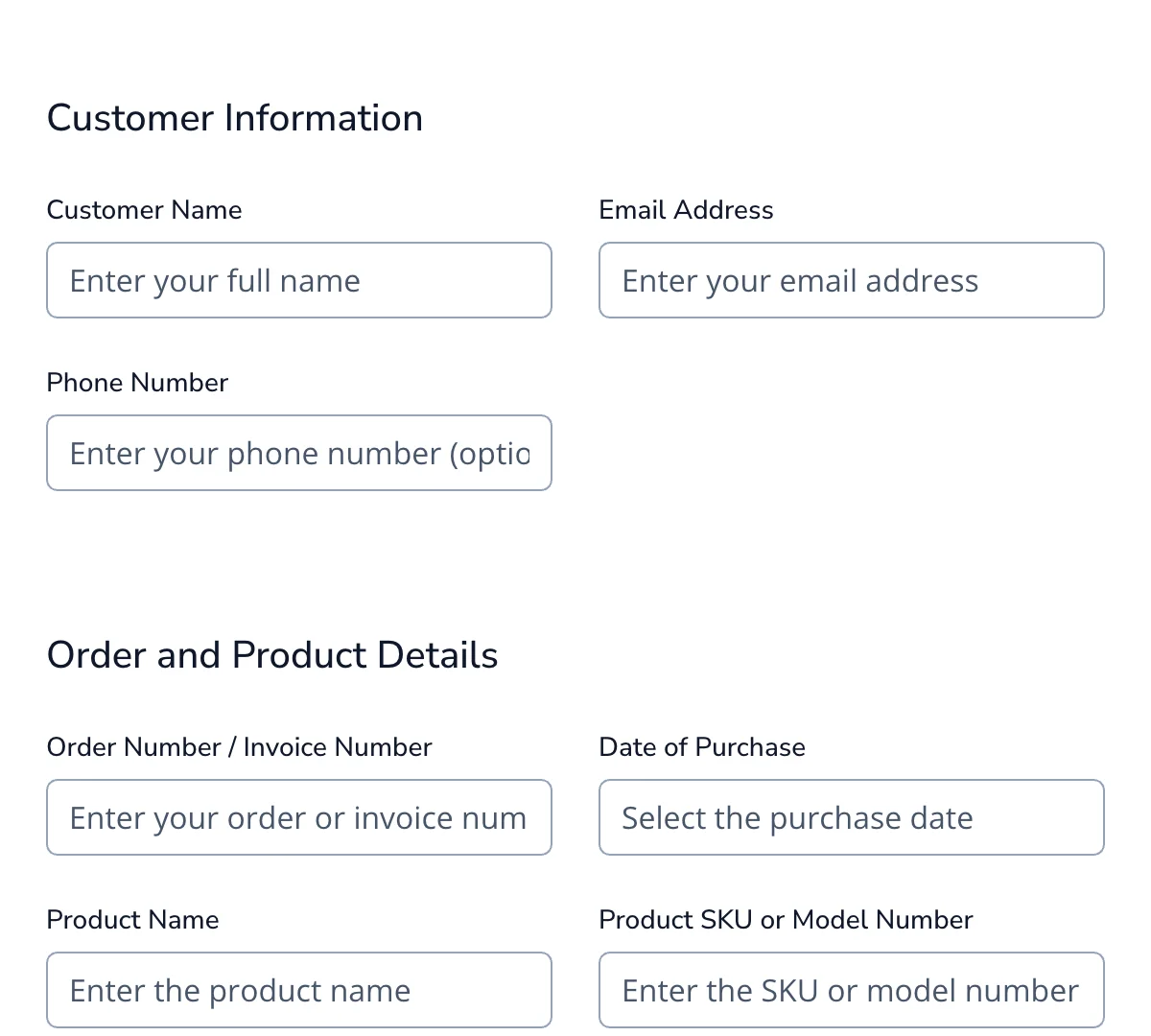
RMA form
Clean, efficient RMA form for smooth product returns and processing.
Get code -
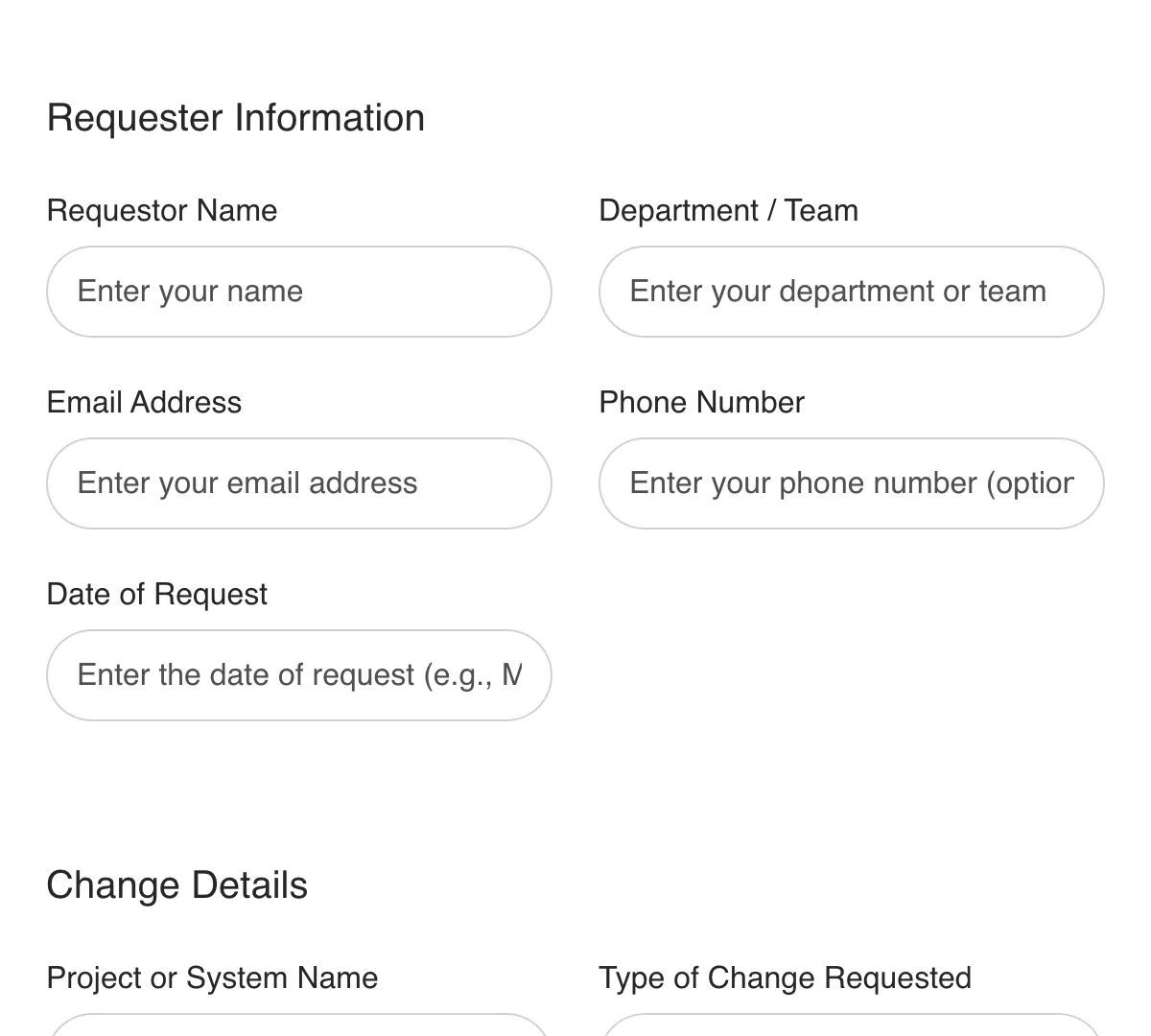
Change Request Form
Clean, easy-to-manage change request form for smooth project updates and tracking.
Get code -
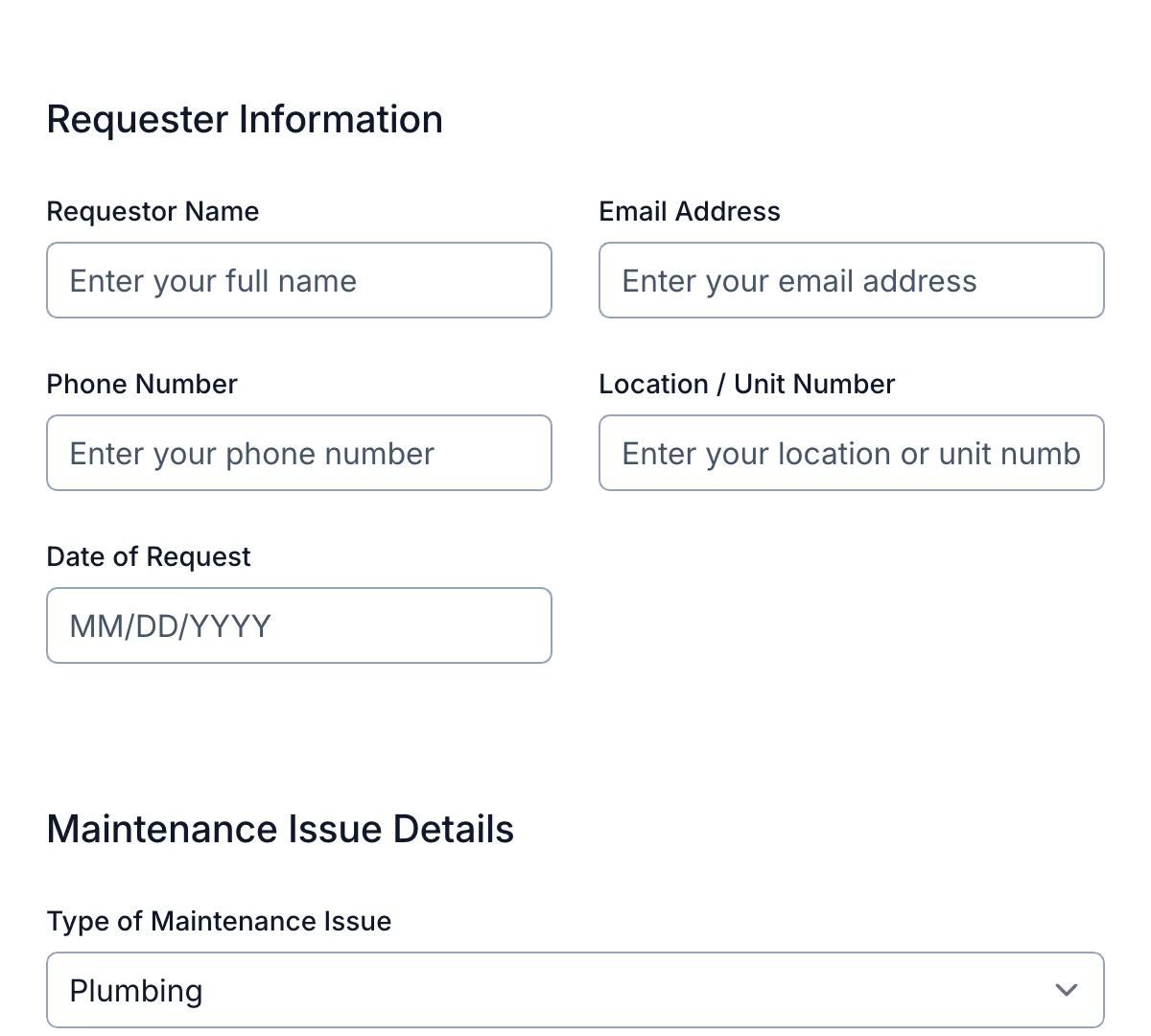
Maintenance Request Form
Clean, user-friendly maintenance request form for quick repair tracking and response.
Get code -
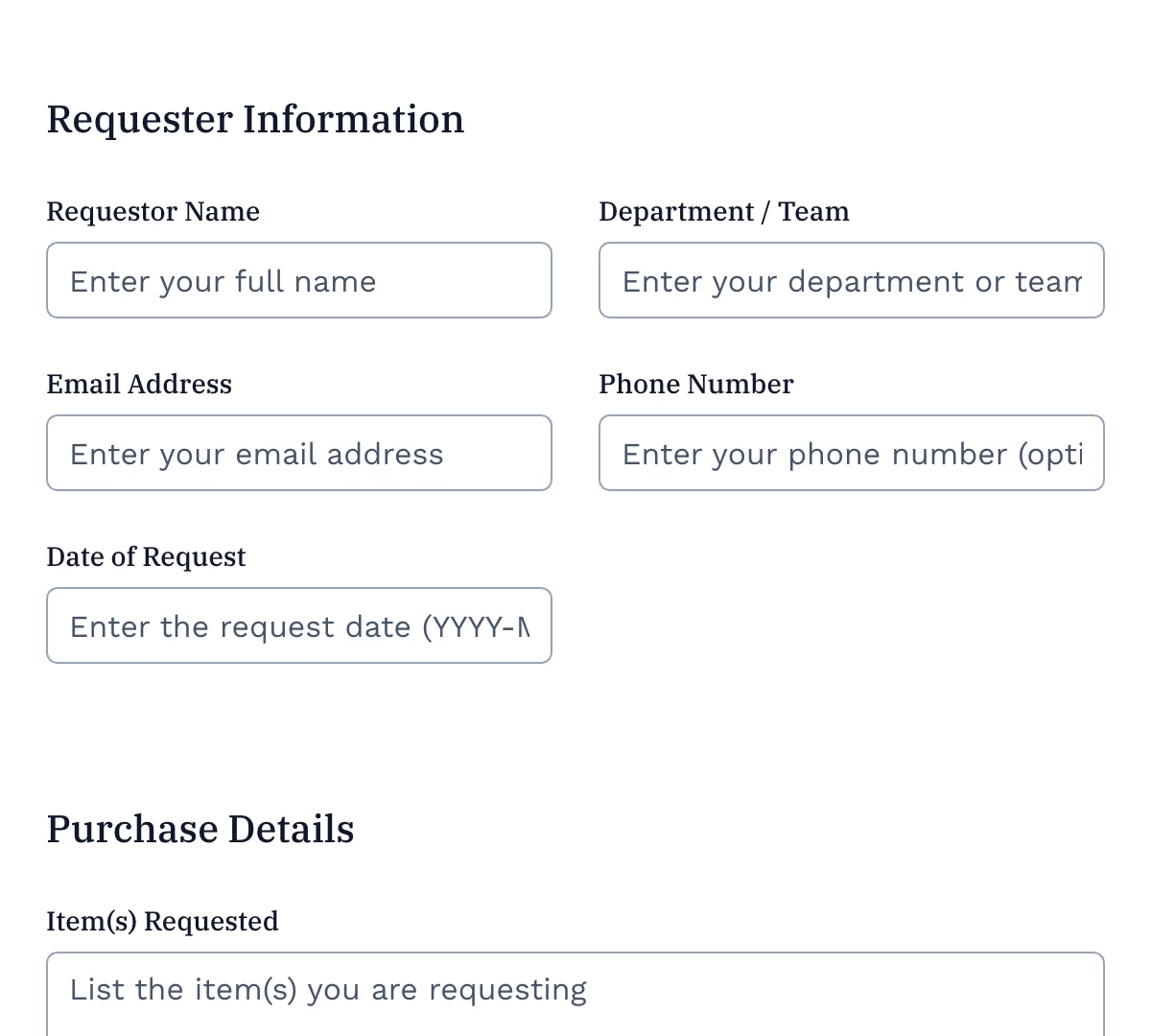
Purchase Request Form
Clean, organized purchase request form for streamlined internal procurement processes.
Get code -
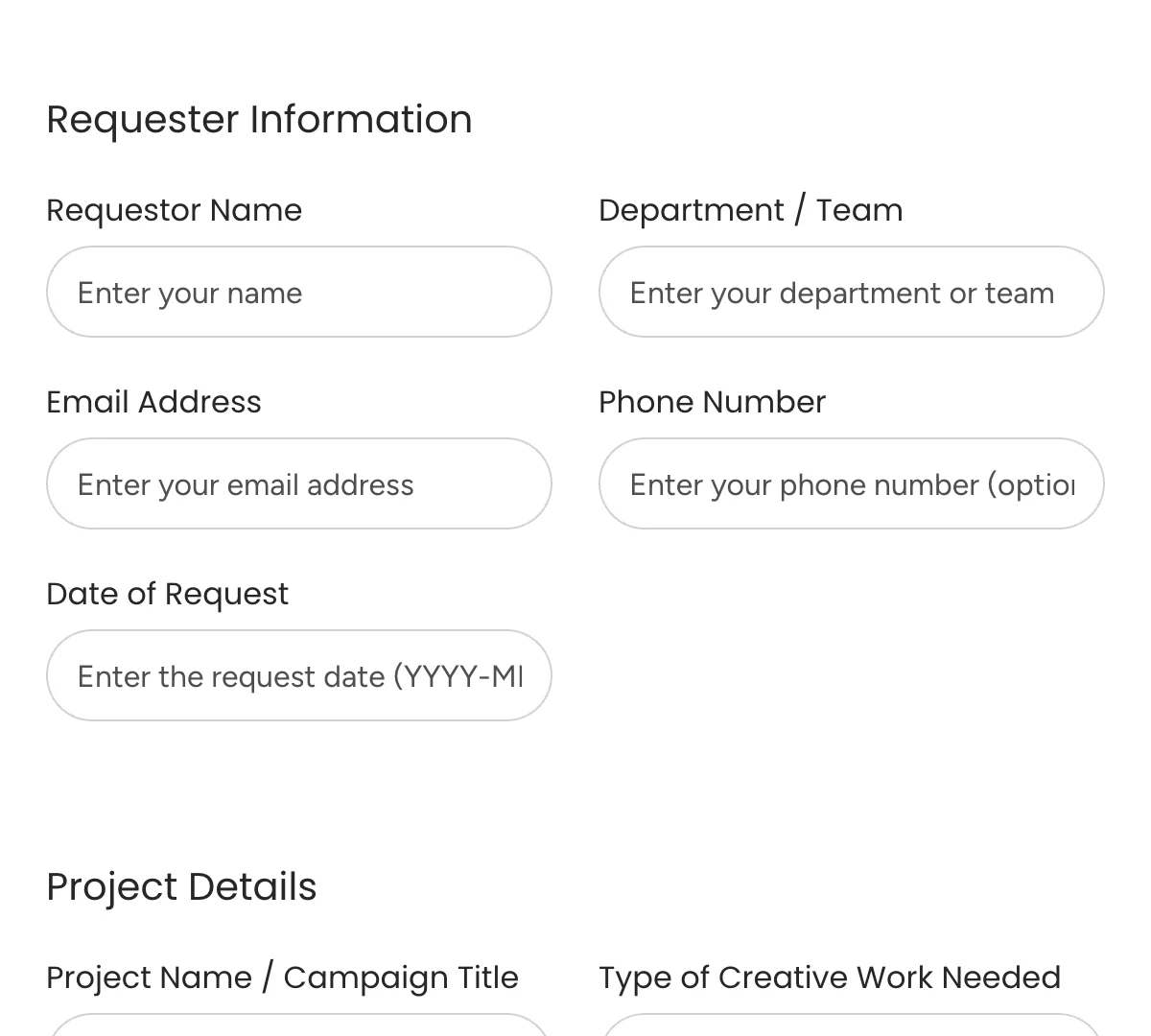
Creative Request Form
Clean, structured creative request form for easy creative project intake and management.
Get code -
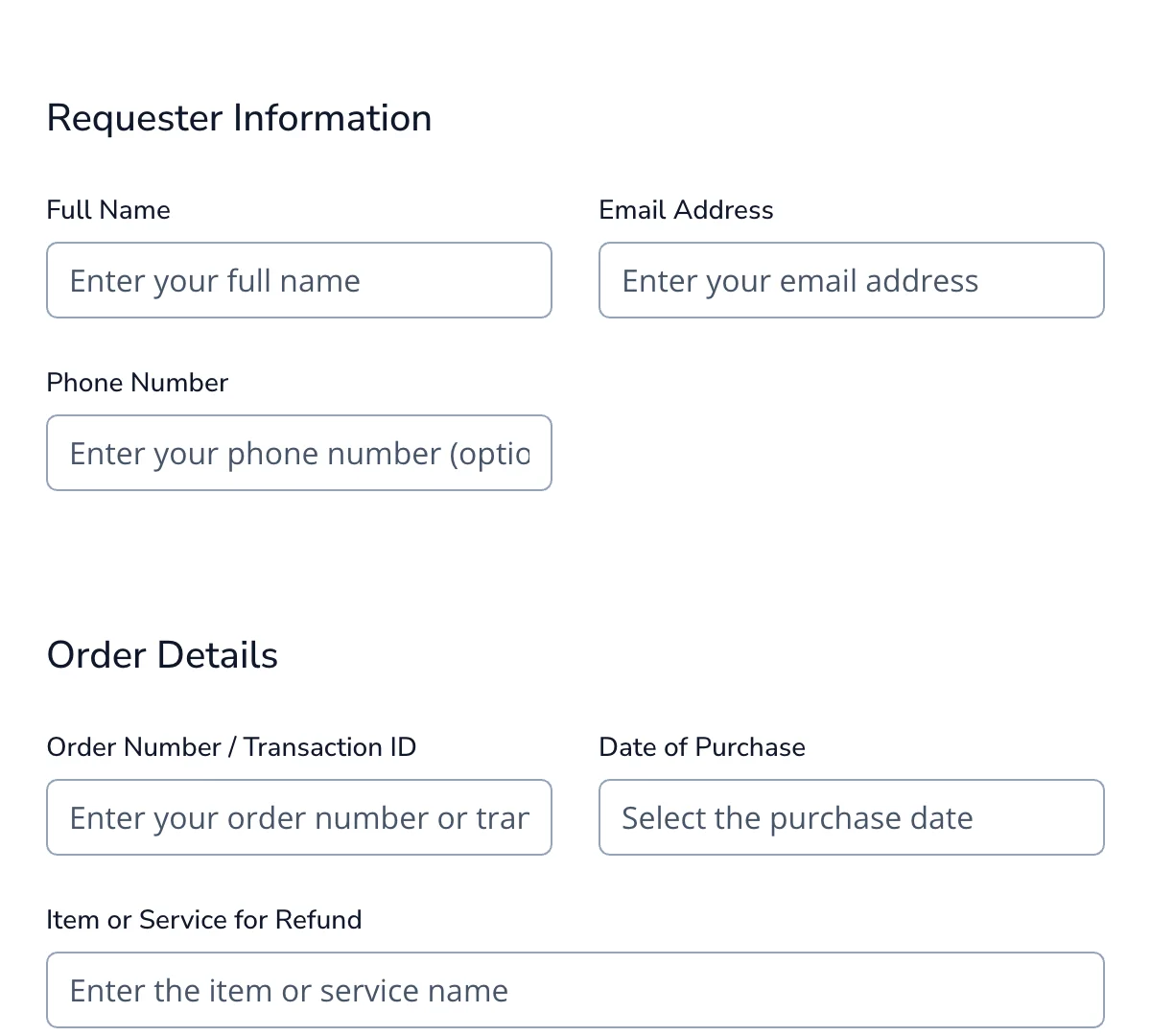
Refund Request Form
Clean, straightforward refund request form for faster and more organized refund management.
Get code -
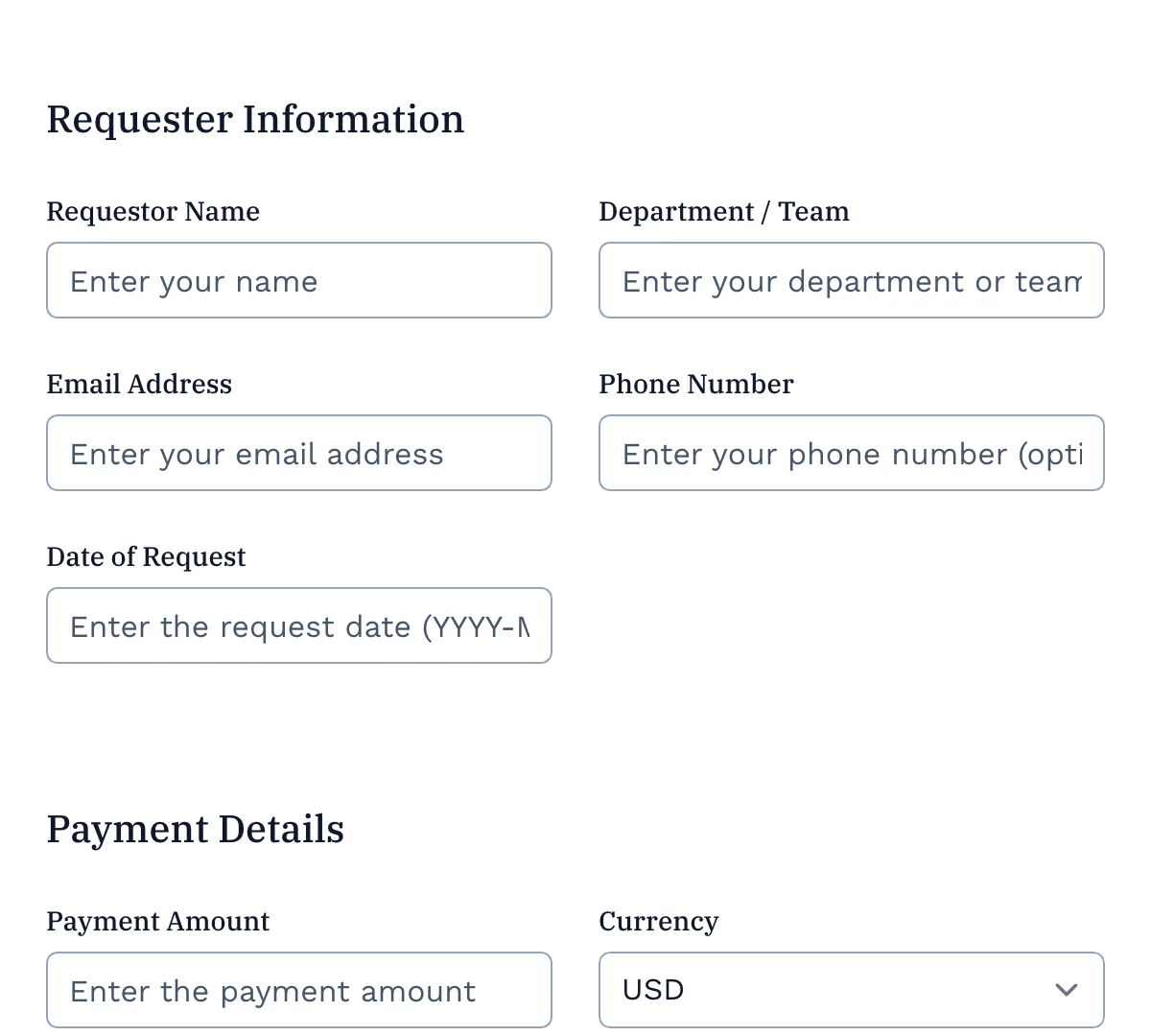
Payment Request Form
Clean, professional payment request form for easy billing and payment tracking.
Get code -
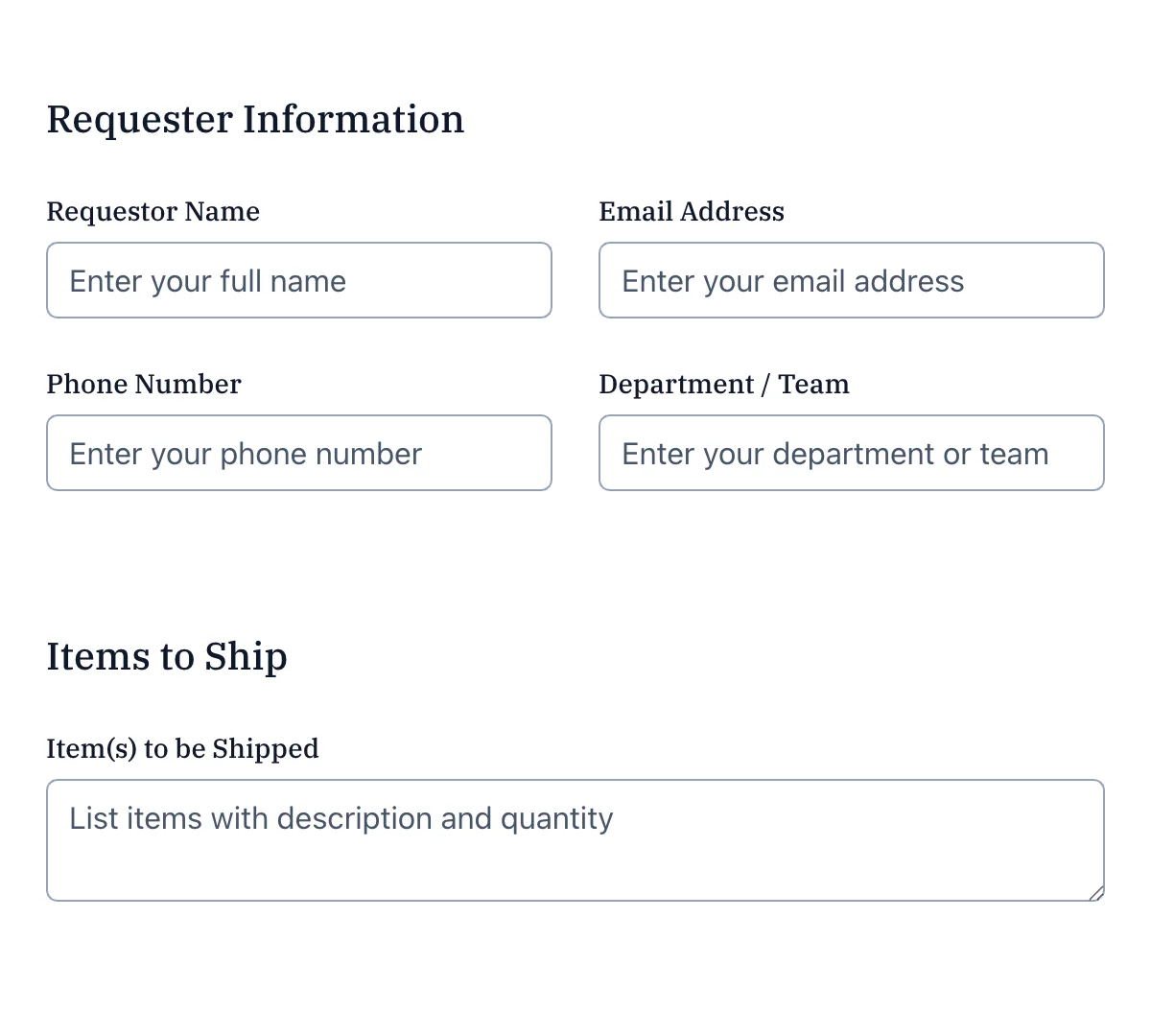
Shipping Request Form
Clean, organized shipping request form for seamless order fulfillment and logistics.
Get code -
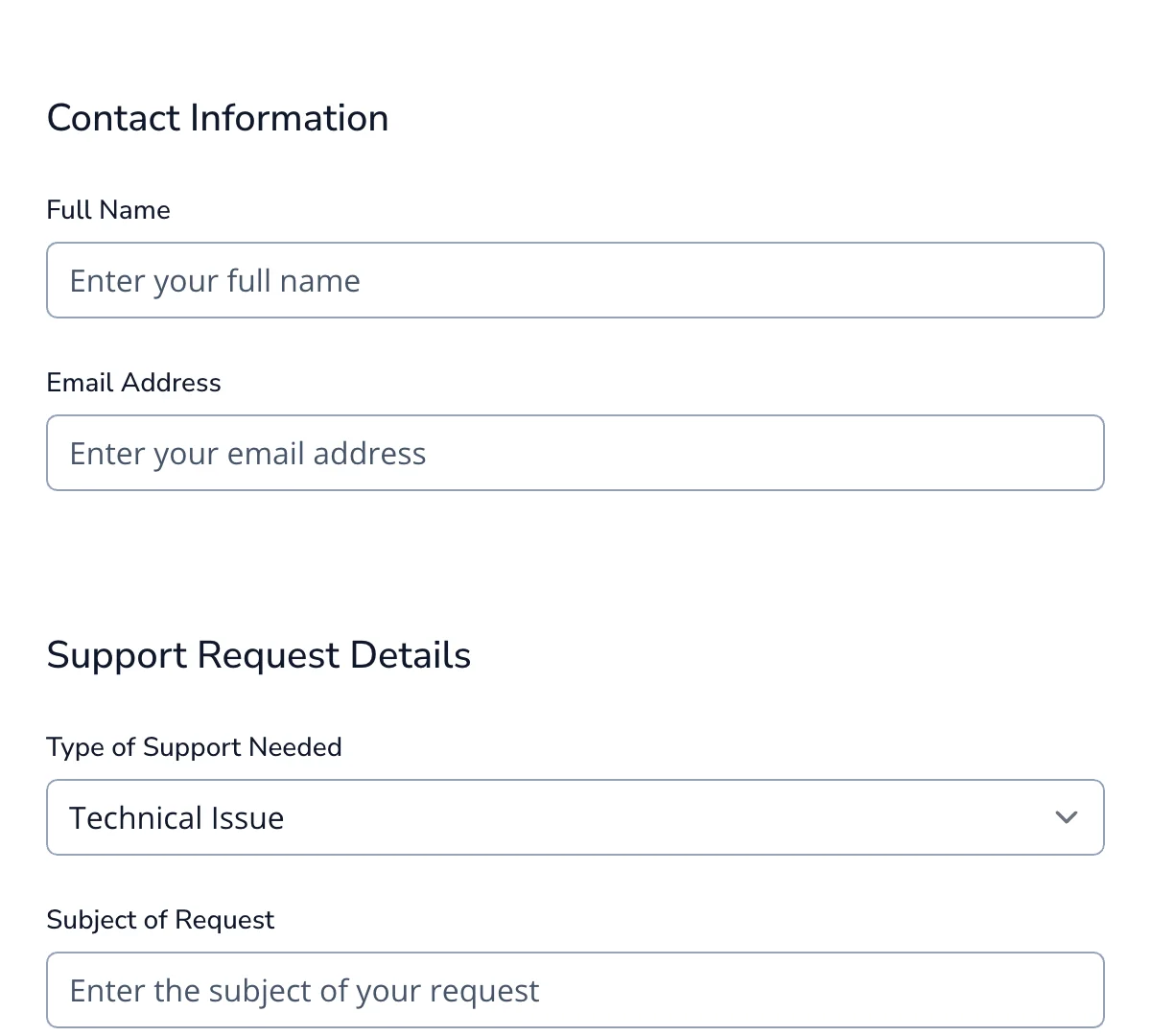
Support Request Form
Clean, easy-to-use support request form for faster customer service and troubleshooting.
Get code
What is a Request Form?
Request forms are one of the most effective tools for organizing inbound requests, whether for services, information, feedback, or resources. By structuring communication into an easily trackable format, request forms simplify operations, improve responsiveness, and enhance the user experience. This article will explore everything you need to know about request forms; from their definitions and common use cases to best practices for design, optimization, and integration.
A request form is a structured document, either physical or digital, that allows individuals to formally submit a request for information, services, permissions, resources, or support. Unlike open-ended emails or informal conversations, request forms organize key details systematically, helping the recipient quickly understand, prioritize, and process the submission. Well-designed request forms are clear, concise, and user-friendly, ensuring that requesters provide all necessary information upfront to minimize back-and-forth communication.
Importance and Common Use Cases
Request forms play a critical role across industries by bringing consistency, traceability, and efficiency to handling inquiries and service demands. Their importance is reflected in a variety of sectors:
- Business: Organizations use request forms for tasks like customer support tickets, product demos, service requests, or internal employee needs such as IT support or leave applications.
- Education: Schools and universities rely on forms for student record requests, event participation, transcript applications, and facility booking.
- Government: Citizens frequently interact with government services through forms to request permits, submit grievances, apply for benefits, or schedule appointments.
- Online Services: Websites use digital request forms to collect user inquiries, feature requests, report issues, and process account-related actions.
Without structured request forms, these interactions would be chaotic and time-consuming, making forms indispensable for scaling operations, improving service quality, and maintaining organized communication.
Types of Request Forms
Request forms come in many varieties, each tailored to the specific type of action or service being requested. Understanding these types helps organizations design more effective workflows and users find the right path to getting their needs met. Some of the most common types include:
- Contact/Support Request Forms: Used to initiate customer service inquiries, technical support tickets, or general communication with an organization.
- Data/Information Request Forms: Enable individuals to formally request access to reports, public records, academic transcripts, or research data.
- Access/Permission Request Forms: Often found in workplaces or educational settings, these forms manage access to tools, facilities, systems, or confidential information.
- Service/Resource Request Forms: Allow users to request services such as maintenance, room bookings, IT assistance, or resource allocation.
- Feedback/Complaint Forms: Designed for collecting user feedback, handling complaints, or gaining insights into how products, services, or experiences can be improved.
Each type of form may require a different set of fields, validations, and workflows, depending on the complexity and sensitivity of the request.
Physical vs. Digital Request Forms
Historically, request forms were paper-based, often filled out manually and submitted in person, by mail, or through fax. While physical forms are still used in some settings (particularly where digital access is limited) most organizations have shifted to digital request forms for their speed, scalability, and ease of management.
- Physical Forms: May be preferred for legal, historical, or archival reasons, but they are more prone to delays, data entry errors, and storage challenges.
- Digital Forms: Offer real-time submission, automated tracking, validation at the point of entry, and integration with other systems like CRM platforms, databases, and helpdesk software.
Digital request forms also enable better user experiences, with features like mobile responsiveness, auto-saving, conditional logic (showing or hiding fields based on responses), and instant confirmation messages. They reduce administrative overhead, make auditing easier, and support analytics to track trends and performance over time.
Key Elements of an Effective Request Form
A well-crafted request form doesn’t just collect information, it makes the experience easy, intuitive, and efficient for users while ensuring that the organization receives complete, actionable data. Several key elements contribute to the effectiveness of a request form:
Essential Fields (Name, Contact, Details of Request)
Every request form should capture the minimum information needed to process a request without overwhelming the user. At a baseline, this usually includes:
- Name: So the request can be attributed to a specific individual.
- Contact Information: Typically an email address, phone number, or both, to allow follow-up communication.
- Details of the Request: A text field, dropdown selection, or combination of fields where the user describes what they are requesting.
Keeping these fields simple and straightforward improves form completion rates and ensures clarity in the information received.
Optional Fields (Attachments, Priority, Department)
While essential fields keep the form lean, optional fields can help further qualify or route the request appropriately:
- Attachments: Allow users to upload supporting documents, screenshots, or forms, which can aid faster processing.
- Priority Level: Users can indicate urgency (e.g., high, medium, low), helping teams triage requests more effectively.
- Department/Team: For organizations with multiple departments, asking users to specify where the request should be directed reduces manual handoffs.
Optional fields should be used thoughtfully to enhance, and not clutter the form experience.
Field Validation and Error Handling
Good request forms include built-in validation to ensure users input information correctly. Common validation features include:
- Required Fields: Prevents users from submitting incomplete forms.
- Email/Phone Validation: Checks for properly formatted contact information.
- Attachment Size Limits: Ensures that uploads are manageable and don’t slow down form performance.
Clear, helpful error messages guide users in correcting mistakes without frustration, leading to higher completion rates and fewer support issues.
User Privacy and Data Security Considerations
Handling user data responsibly is critical when building request forms. Every form collects at least some personal information, like names, email addresses, or phone numbers, and in some cases more sensitive details. Poor handling of this information can lead to privacy breaches, legal issues, and loss of user trust.
Best practices include:
- Using HTTPS to encrypt data transmissions between the user’s browser and your server.
- Collecting only what you need to minimize data exposure risks.
- Displaying a privacy notice or linking to your privacy policy near the form submission button to inform users how their data will be used.
- Implementing access controls to ensure that only authorized personnel can view or manage form submissions.
- Storing data securely with encryption at rest, and establishing clear retention policies for deleting data once it’s no longer needed.
Especially if the form collects sensitive or regulated information (such as health or financial data), compliance with standards like GDPR, HIPAA, or CCPA becomes mandatory.
Designing a User-Friendly Request Form
Creating a user-friendly request form is about making it easy for people to complete the form correctly and quickly. Good design reduces friction, increases submission rates, and lowers the number of incomplete or incorrect entries.
Visual Structure and Layout
A clear, logical structure is essential. Group related fields into sections or use headings to break up long forms. Place the most important and easy-to-answer questions first to encourage users to continue. Also, avoid overcrowding. Use whitespace and consistent alignment to make the form easier to scan and fill out.
Mobile Responsiveness and Accessibility
Request forms must work well on all devices, especially mobile phones and tablets. Forms should resize automatically for different screen sizes, and fields should be large enough to tap easily. Accessibility is equally important: labels must be associated with inputs correctly, keyboard navigation should be smooth, and screen reader users should be able to understand and complete the form without barriers.
Use of Contextual Help and Tooltips
Contextual help, like tooltips or short explanations below form fields, helps users understand what is being asked without overwhelming them. For example, if a form asks for a “Department Code,” a small tooltip can explain where to find it. This reduces confusion and form errors.
Minimizing Friction (Auto-fill, Dropdowns, Conditional Logic)
Anything that speeds up form completion improves the user experience. This includes:
- Auto-fill for common fields like name and email.
- Dropdown menus for standardized selections instead of open text fields.
- Conditional logic to show or hide fields based on previous answers, keeping the form shorter and more relevant to each user.
Minimizing unnecessary typing and choices makes it more likely users will finish and submit the form.
Optimizing Request Forms for Conversion
Even a well-designed form can underperform if it’s not optimized for conversions, meaning users abandon it before submitting. A few key strategies can help maximize submission rates:
Reducing Form Abandonment (Short Forms, Progress Bars)
Shorter forms perform better. Only ask for essential information upfront and leave optional or additional questions for later stages if necessary. If your form is long, break it into smaller sections and add a progress bar. Showing users where they are in the process reduces anxiety and encourages them to complete the form.
Clear Calls-to-Action (Submit, Reset, Save Draft)
The Submit button should be highly visible and use clear, action-oriented text (e.g., “Submit Request,” “Send Message”). Avoid confusing options like “Reset” unless absolutely necessary, as users can accidentally erase their work. If your form is complex, offering a Save Draft feature is valuable, allowing users to return and complete it later.
Confirmation Messages and Next Steps
Immediately after submission, show a clear confirmation message telling the user that their request was received. Good confirmation pages also set expectations about what happens next (for e.g., “You’ll hear from our team within 24 hours”) helping reduce follow-up inquiries.
Follow-up Automation (Email Notifications, Ticketing Systems)
Automated follow-up improves transparency and user satisfaction. Using a forms backend service like Formspree, you can instantly send:
- Confirmation emails to users upon submission
- Notification emails to your team for new requests
- Webhook triggers to integrate with ticketing systems or workflows
Formspree’s built-in workflow automation features make it easy to manage these processes without writing server-side code, helping you focus on responding rather than managing submissions manually.
Integrating Request Forms with Other Tools
Web forms are rarely used in isolation. They are often the starting point for larger workflows involving notifications, task management, customer relationship management (CRM), marketing automation, and payments. Formspree makes it easy to integrate your request forms with the tools you already use, enabling faster, smarter follow-up without custom server-side development.
Notifications and Team Collaboration
Formspree allows you to instantly route form submissions to communication channels where your team already works. You can:
- Send email notifications to specific team members.
- Post new submissions directly into Slack, Discord, or Telegram channels to ensure fast team visibility.
- Set up auto-response emails to confirm receipt to the user without delay.
This ensures every request is acknowledged and routed to the right team without manual intervention.
CRM and Customer Support Integration
Managing customer relationships and support requests becomes easier when forms are connected to your CRM and helpdesk systems. Formspree supports direct integration with:
- CRM platforms like HubSpot, Pipedrive, and Salesforce, allowing you to create or update contacts and leads automatically when a form is submitted.
- Support tools like Freshdesk, Zendesk, Gladly, and Gorgias, helping you turn form submissions into actionable tickets or support conversations immediately.
Task Management and Productivity Integration
For internal workflows, Formspree integrates with:
- Project management platforms like Trello, Asana, and Notion, enabling you to create tasks or update boards when a form is submitted.
- Airtable and Google Sheets, allowing you to automatically log submissions into databases or spreadsheets for tracking, reporting, or collaborative work.
This makes it easy to manage operational requests, content submissions, or resource requests inside tools your teams already use daily.
Marketing Automation and Email Campaigns
Request forms can also feed into your marketing efforts. Formspree connects with email marketing platforms like Mailchimp, MailerLite, ConvertKit, Klaviyo, and Constant Contact.
You can automatically add new subscribers, update lists, or trigger email automation based on form submissions. This allows you to use forms not just for immediate requests but also to grow your audience and nurture ongoing engagement.
Payment and Webhook Automation
Formspree even supports more advanced workflows, such as:
- Stripe integration, allowing you to accept payments within forms.
- Zapier integration for no-code automation across thousands of other apps and services.
- Webhook triggers that let you connect your form to any custom backend or internal system.
These capabilities make Formspree suitable for complex workflows like paid service requests, event registrations, or internal system updates; all starting from a simple form.
Common Challenges and Solutions
Even with best practices in place, request forms can face real-world challenges. Recognizing these early and planning solutions will help you maintain a smooth user experience.
- Handling Large Volumes of Requests: If your form becomes popular (for instance, during event registrations or customer support spikes), you may face sudden surges in submissions. Using a service like Formspree, which is built to scale automatically, ensures that high submission volumes don’t result in failed form loads or lost data. Load testing and backup workflows can also be part of your preparation.
- Preventing Spam and Bots (CAPTCHA, Verification): Online forms are frequent targets for spam bots. Implementing CAPTCHA or other verification methods (like honeypot fields or email domain validation) is critical. Formspree supports spam protection features natively, including reCAPTCHA, so you can add bot defenses without complicating your form setup.
- Multi-language and Localization Support: If your audience speaks multiple languages, your forms must reflect that. You can either create different forms for each language or build dynamic multi-language support based on user preferences.
Measuring Success: Metrics and Optimization
After launching a request form, it’s important to track how it performs. Measurement helps identify problems, optimize completion rates, and improve the overall user experience over time.
Key Performance Indicators (KPIs): Submission Rate, Completion Rate, Response Time
Some key metrics to monitor include:
- Submission Rate: The number of people who actually submit the form versus those who view it.
- Completion Rate: Especially for longer or multi-step forms, how many users finish all steps.
- Response Time: How quickly your team responds to submissions. Faster response times lead to better user satisfaction and trust.
A/B Testing Form Variations
Testing different versions of your form can reveal what works best. For example, you might compare:
- Shorter vs. longer forms
- Different wording on the submit button
- Different placement of optional fields
Consider deploying alternate version of the same form so you can A/B test layouts, fields, or messages and analyze which version leads to better conversion rates.
User Feedback Loops
Sometimes the best optimization ideas come directly from users. Include an optional feedback step after a form submission asking questions like “Was this form easy to use?” or “How could we improve it?” Over time, small refinements based on real user input can dramatically improve form performance.
Conclusion
Request forms are essential tools for collecting structured information, improving service delivery, and managing inbound requests across industries. A well-designed request form streamlines both the user experience and internal workflows, ensuring faster, more efficient handling of submissions.
Using a platform like Formspree simplifies building, securing, automating, and scaling request forms without needing server-side code. With built-in integrations, spam protection, analytics, and automation capabilities, Formspree empowers businesses, schools, governments, and online services to create professional-grade request forms with minimal effort.
As with any user-facing tool, continuous testing, feedback collection, and optimization are key. By following best practices and iterating based on real-world usage, you can turn a basic form into a powerful engine for user engagement and operational success.